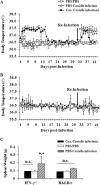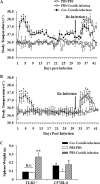Attenuated Coxiella burnetii phase II causes a febrile response in gamma interferon knockout and Toll-like receptor 2 knockout mice and protects against reinfection
- PMID: 17893129
- PMCID: PMC2168348
- DOI: 10.1128/IAI.00901-07
Attenuated Coxiella burnetii phase II causes a febrile response in gamma interferon knockout and Toll-like receptor 2 knockout mice and protects against reinfection
Abstract
Coxiella burnetii is a highly infectious obligate intracellular bacterium. The phase I form is responsible for Q fever, a febrile illness with flu-like symptoms that often goes undiagnosed. The attenuated C. burnetii phase II (having a truncated "O" chain of its lipopolysaccharide) does not cause disease in immunocompetent animals; however, phase II organisms remain infectious, and we questioned whether disease could be produced in immunodeficient mice. To study C. burnetii phase II infections, febrile responses in gamma interferon knockout (IFN-gamma(-/-)), BALB/c, Toll-like receptor 2 knockout (TLR2(-/-)), and C57BL/6 mice were measured using the Nine Mile phase II (NMII) strain of C. burnetii. Immunocompetent mice showed minimal febrile responses, unlike those obtained with IFN-gamma(-/-) and TLR2(-/-) mice, which showed elevated rectal temperatures that were sustained for approximately 15 days with transient increases in splenic weights. Reinfection of IFN-gamma(-/-) and TLR2(-/-) mice with C. burnetii NMII 30 days after primary infection protected mice as evident by reduced febrile responses and a lack of splenic inflammation. Although minimal detection of Coxiella in TLR2(-/-) mouse spleens was observed, greater colonization was evident in the IFN-gamma(-/-) mice. Cytokine analysis was performed on infected peritoneal macrophages isolated from these mice, and immunocompetent macrophages showed robust tumor necrosis factor alpha, IFN-gamma, and granulocyte-macrophage colony-stimulating factor (GM-CSF) but no interleukin-12 (IL-12) responses. IFN-gamma(-/-) macrophages produced elevated levels of IL-6, IL-10, and IL-12, while TLR2(-/-) macrophages produced GM-CSF, IL-12, and minimal IL-10. To distinguish immunity conferred by innate or adaptive systems, adoptive transfer studies were performed and showed that immune lymphocytes obtained from immunocompetent mice protected against a subsequent challenge with NMII, indicating that adaptive immunity mediates the observed protection. Thus, our data show that NMII is capable of eliciting disease in immunocompromised mice, which may help in evaluation of vaccine candidates as well as the study of host-pathogen interactions.
Figures










Similar articles
-
The Feasibility of Using Coxiella burnetii Avirulent Nine Mile Phase II Viable Bacteria as a Live Attenuated Vaccine Against Q fever.Front Immunol. 2021 Oct 21;12:754690. doi: 10.3389/fimmu.2021.754690. eCollection 2021. Front Immunol. 2021. PMID: 34795669 Free PMC article.
-
T cells are essential for bacterial clearance, and gamma interferon, tumor necrosis factor alpha, and B cells are crucial for disease development in Coxiella burnetii infection in mice.Infect Immun. 2007 Jul;75(7):3245-55. doi: 10.1128/IAI.01767-06. Epub 2007 Apr 16. Infect Immun. 2007. PMID: 17438029 Free PMC article.
-
Coxiella burnetii Nine Mile phase I primary infection derived protective immunity against C. burnetii reinfection in mice depends on both B and T cells, but T cells play a critical role.Front Immunol. 2024 Oct 14;15:1427822. doi: 10.3389/fimmu.2024.1427822. eCollection 2024. Front Immunol. 2024. PMID: 39469719 Free PMC article.
-
Adaptive immunity to the obligate intracellular pathogen Coxiella burnetii.Immunol Res. 2009;43(1-3):138-48. doi: 10.1007/s12026-008-8059-4. Immunol Res. 2009. PMID: 18813881 Free PMC article. Review.
-
Coxiella burnetii Lipopolysaccharide: What Do We Know?Int J Mol Sci. 2017 Nov 23;18(12):2509. doi: 10.3390/ijms18122509. Int J Mol Sci. 2017. PMID: 29168790 Free PMC article. Review.
Cited by
-
Right on Q: genetics begin to unravel Coxiella burnetii host cell interactions.Future Microbiol. 2016 Jul;11(7):919-39. doi: 10.2217/fmb-2016-0044. Epub 2016 Jul 15. Future Microbiol. 2016. PMID: 27418426 Free PMC article. Review.
-
Preclinical Animal Models for Q Fever Vaccine Development.Front Cell Infect Microbiol. 2022 Feb 10;12:828784. doi: 10.3389/fcimb.2022.828784. eCollection 2022. Front Cell Infect Microbiol. 2022. PMID: 35223553 Free PMC article. Review.
-
Murine and bovine γδ T cells enhance innate immunity against Brucella abortus infections.PLoS One. 2011;6(7):e21978. doi: 10.1371/journal.pone.0021978. Epub 2011 Jul 12. PLoS One. 2011. PMID: 21765931 Free PMC article.
-
Robust growth of avirulent phase II Coxiella burnetii in bone marrow-derived murine macrophages.PLoS One. 2017 Mar 9;12(3):e0173528. doi: 10.1371/journal.pone.0173528. eCollection 2017. PLoS One. 2017. PMID: 28278296 Free PMC article.
-
Nasal Acai polysaccharides potentiate innate immunity to protect against pulmonary Francisella tularensis and Burkholderia pseudomallei Infections.PLoS Pathog. 2012;8(3):e1002587. doi: 10.1371/journal.ppat.1002587. Epub 2012 Mar 15. PLoS Pathog. 2012. PMID: 22438809 Free PMC article.
References
-
- Andoh, M., K. E. Russell-Lodrigue, G. Zhang, and J. E. Samuel. 2005. Comparative virulence of phase I and II Coxiella burnetii in immunodeficient mice. Ann. N. Y. Acad. Sci. 1063:167-170. - PubMed
-
- Arricau-Bouvery, N., and A. Rodolakis. 2005. Is Q fever an emerging or re-emerging zoonosis? Vet. Res. 36:327-349. - PubMed
-
- Bohnet, S. G., T. R. Traynor, J. A. Majde, B. Kacsoh, and J. M. Krueger. 2004. Mice deficient in the interferon type I receptor have reduced REM sleep and altered hypothalamic hypocretin, prolactin and 2′,5′-oligoadenylate synthetase expression. Brain Res. 1027:117-125. - PubMed
Publication types
MeSH terms
Substances
Grants and funding
LinkOut - more resources
Full Text Sources
Other Literature Sources
Molecular Biology Databases

